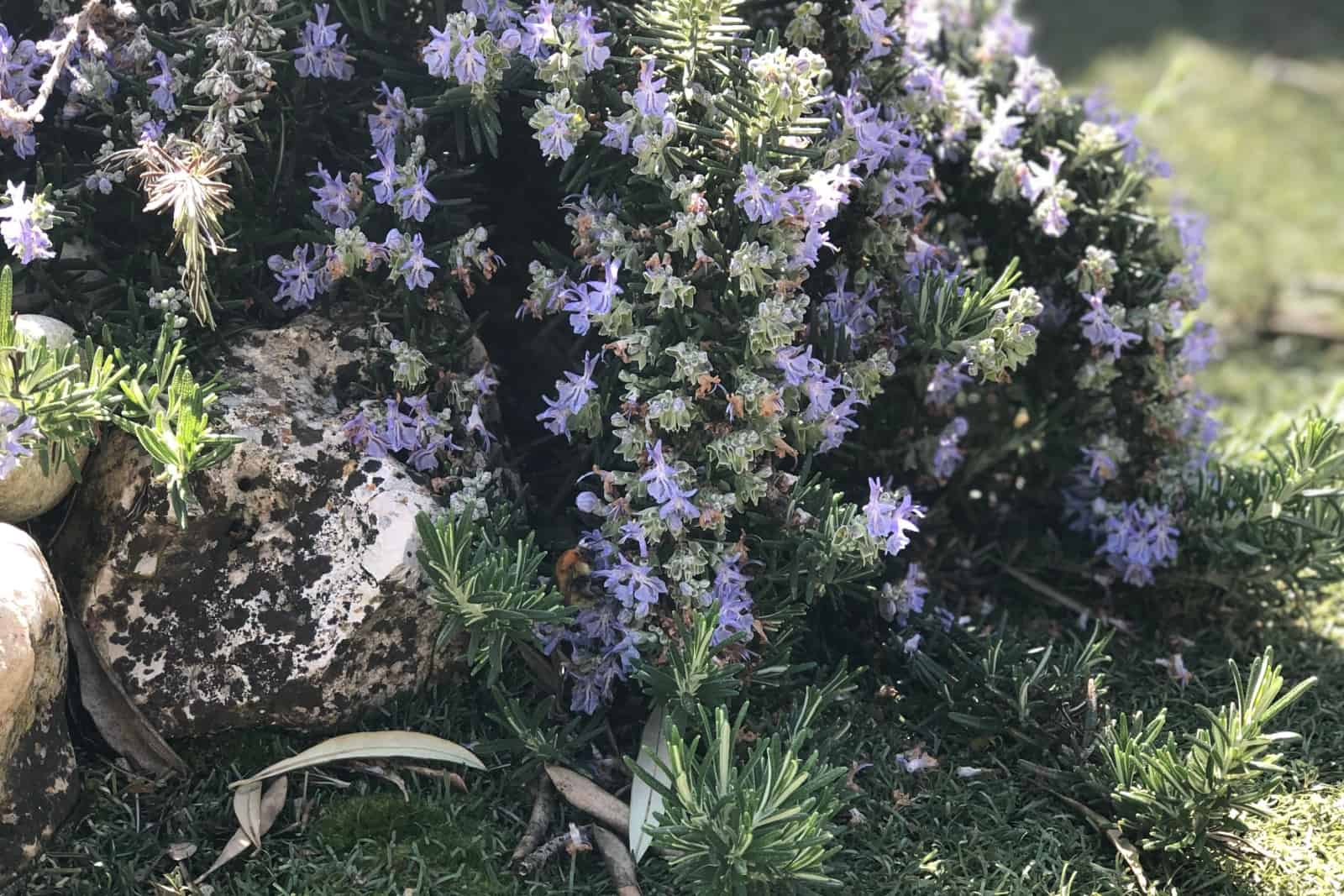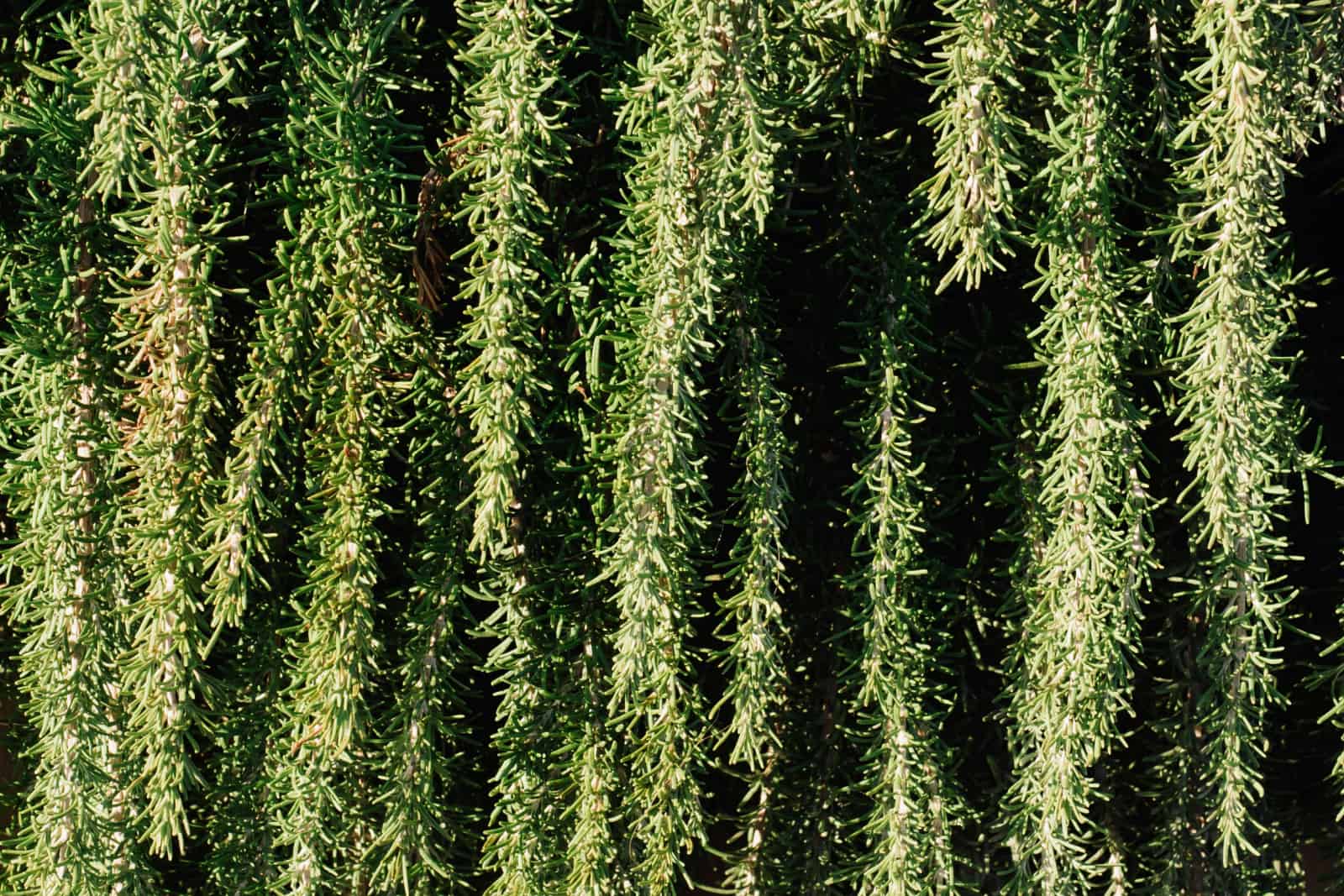Trailing rosemary is an edible fragrant herb that you can use as a ground cover in your garden. You can also control its bushy appearance by planting it in a pot.
It is a perfect addition to many dishes, repels pests, and attracts pollinators and natural predators to keep infestations at bay.
Another benefit of this aromatic herb is that it doesn’t need too much care to thrive; simply plant it in a sunny location, occasionally water it, and ensure its growing medium is well-draining.
Before we examine these needs in more detail, let’s learn some basics about this evergreen shrub:
[table id=603 /]
How To Grow Trailing Rosemary In The Garden
The trailing rosemary plant requires full sun, occasional supplemental watering if you live in a dry region, and moderately fertile soil with good drainage.
You don’t have to fertilize this plant very often, but you should prune it to avoid the branches becoming woody.
We’ll discuss this and some other needs you should pay attention to in order to nurture a healthy plant.
Light Requirements
Rosemary plants require full sun conditions to thrive, so you should grow this plant in a sunny location that gets 6-8 hours of direct light each day (at least).
This herb can also tolerate light shade, but it will not have as many pale blue flowers and its foliage may not be as robust.
If you live in a warm region, you may need to provide some afternoon shade to prevent the plant from getting too hot and burning in the sun.
Water And Humidity
Prostrate rosemary is a fairly drought-tolerant plant, but you still need to water it every 1-2 weeks to promote deep root growth and keep it healthy.
Rainwater is good for plants, although you can also use distilled water or tap water if you leave it in the air for a day to let the chlorine evaporate.
You should also check the growing medium for moisture, and water this plant only when the top few inches of the soil is dry to avoid root rot. Layering some mulch at the base of the plant can help retain some moisture, which is especially helpful during hot, dry weather.
Finally, avoid wetting the foliage since that can encourage the development of fungal diseases.
Humidity
Rosemary plants prefer dry air and can tolerate low to moderate humidity levels.
If you live in a humid region, you must provide good air circulation and ensure you plant it about 2-3 feet away from any other plants.
Temperature
For optimal growth and the best flavor, you should grow rosemary at average temperatures between 60 and 70 degrees Fahrenheit.
If you’re growing it in a pot, you can always take it indoors over winter to protect it from freezing temperatures.
Soil And Fertilizer
The best substrate for growing rosemary is well-drained soil with a slightly alkaline pH between 6.5 and 7.0, though it can tolerate a somewhat wider range of pH levels.
(If your soil is too acidic, add lime to raise the pH. Conversely, if your soil is too alkaline, you can add sulfur to lower the pH.)
Also, rosemary prefers sandy or gravelly soil that allows excess water to drain away quickly. To provide the best growing conditions for your rosemary plant, you can mix in some compost or manure to add organic matter and nutrients to the soil.
You can also add a layer of mulch around the base of the plant to help retain moisture and suppress weed growth.
Fertilizer
Rosemary is a hardy herb that doesn’t require too much fertilizer, but you can feed it a couple of times during its growing season. Use a well-balanced fertilizer, but don’t go overboard with nitrogen.
You can also examine the differences between compost and fertilizer to see which option would be better for this perennial herb.
Propagation
You can propagate rosemary by dividing the mother plant into more parts if each has separate root systems. Or you can multiply it through stem cuttings and nurture new plants that way.
Here are the steps for propagating with rooting cuttings:
Step 1. Choose a healthy stem with at least 3-4 pairs of leaves, and snip it off with clean and sharp scissors. Strip off the bottom foliage, leaving only the top leaves intact. This will help reduce moisture loss and prevent the cutting from rotting.
Step 2. Dip the cut end of the stem into a rooting hormone. This will help encourage root development and improve the chances of successful rooting.
Step 3. Fill a small pot with well-drained soil (a seed starting mix works well) and water it until it is evenly moist.
Step 4. Plant the cutting into the medium, gently firm the soil around the cutting to secure it in place, and place it in a warm, sunny location. Keep the soil moist, and consider covering the cuttings with a humidity dome to prevent the green leaves from drying out.
After a few weeks, you should see new growth, and once the root system establishes a bit, you can transplant it into a larger pot.
Repotting Creeping Rosemary
The best time for repotting prostrate rosemary is in spring when it actively grows, although you won’t have to do this very often since it isn’t an avid grower.
The first thing you need to do is choose a suitable rosemary planter, such as a terracotta one with drainage holes that’s about 12 inches in diameter.
Fill the container with well-drained soil, place this low-growing herb in the middle of it, and add more medium around the roots.
Pro tip: Repot your trailing rosemary every 2-3 years to give it more room to grow and prevent it from becoming rootbound.
Pruning
Prune your trailing rosemary every couple of months to maintain a healthy plant, encourage new growth, improve the shape, and remove any damaged or diseased branches.
The best time to trim this plant is in spring or early summer, right after it finishes producing its pale blue or white flowers. This will give it enough time to put on new growth and prepare for the winter.
First, remove any damaged, diseased, or dry branches to maintain a healthy plant, and then remove all leggy stems that taint the looks of your perennial herb.
And if your plant grows too fast, you can cut it back more aggressively, although the general rule is never to remove more than ⅓ at a time.
Here are some more pruning tips:
More About The Rosmarinus Officinalis ‘Prostratus’
The Rosmarinus officinalis ‘Prostratus’ has a couple of common names, such as trailing rosemary, creeping rosemary, and prostrate rosemary.
This plant is known for its irresistible scent, aromatic oil, and culinary uses. It looks fantastic in your herb garden, and can repel pests and attract beneficial organisms, which is why there are so many companion plants for rosemary.
We’ll discuss these things in more detail in the following sections.
Features
This plant has a trailing growth habit and typically has small, needle-like green leaves and blossoms with a flower color that ranges from pale blue to white.
Uses
Trailing rosemary is a xeriscape plant, so you can use it in your garden design if you don’t have any other inexpensive desert landscape ideas. It is an excellent ground cover and perfect for rock gardens due to its drought tolerance.
You can use it for culinary purposes because of its intense aroma, or as a pest-repellent in your yard.
Final Thoughts
Trailing rosemary is an aromatic herb that requires full sun for the best growth, well-drained soil, some water when the top soil feels dry to the touch, and occasional feeding.
You should prune this plant once in a while to control its growth and keep it healthy.
We also brought propagation and repotting tips, and included some main features and uses for this herb.Enjoy the fragrant trailing rosemary, and until next time!
Like this post? Share or pin it for later!




